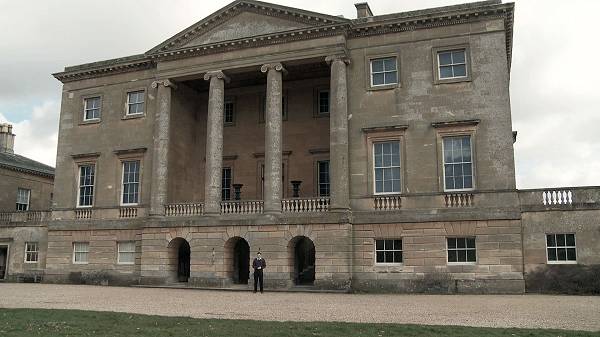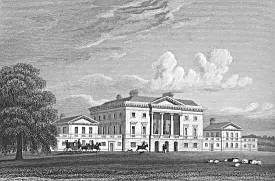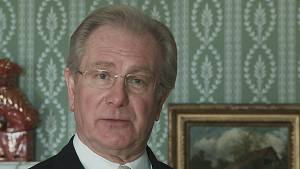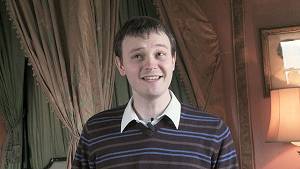
|
The world of non-commercial film and A-V |
Events Diary | Search | ||
| The Film and Video Institute | | ||||
The making of Love Basildon Park
At BIAFF 2010 Geoff Addis won a Diamond Award and a sponsors prize from
Carlin Music with Love Basildon Park.
As with all National Trust properties, the house relies upon volunteers to act as guides and my wife, Anna, is one of the Basildon team. It was late November 2008, a typically gloomy and wet autumn day, when Anna returned home after the last day of the season; the following day the property was to close for winter. "Good news," she calls, "Basildon want you to make a film for visitors to see." |
The house has been featured in a number of films, most notably Pride and Prejudice starring Keira Knightley and various television commercials. It is open to the public daily from the beginning of March through to late November.
Basildon Park in 1829, from Jones' |
Designed by John Carr of York and built for Sir Francis Sykes in the
grounds of the former Basildon Manor, Basildon Park overlooks the Thames
valley a few miles West of Reading; building commenced in 1776 and took eight
years to complete.
The most recent owners to live there were Lord and Lady Iliffe and it was in 1978 that Lord Iliffe handed over the property to the care of the National Trust. Lady Iliffe continued to live there until her death in 2007, Lord Iliffe having died in 1996. The house has a chequered past and almost fell into ruin after WW II when it had been requisitioned to accommodate soldiers of various nationalities and eventually German prisoners of war. Lady Iliffe wrote that having first seen the house in 1938 it was in 1952 that, out of curiosity, she re-visited Basildon Park to discover that it was in an almost derelict state. No windows were intact, most being covered with cardboard or plywood and, because of fire damage, there was a large puddle on the library floor where water had entered from the room above; throughout the house, the walls were covered with signatures and graffiti from its wartime occupants. "However", she went on to write, "there is still a feeling of its former elegance and a great solidity." Despite the strict rationing of building materials and the formidable task ahead, the Iliffes bought the property and set about its restoration, much of the decoration and soft furnishings being the work of the hard working Lady Iliffe. |
The idea of filming the grandeur of 17th and 18th century country mansion immediately caught my imagination; those beautiful paintings by Charles de la Fosse, Sutherland's sketches for the Christ in Glory tapestry in Coventry Cathedral, the almost priceless porcelain, decorated ceilings and stories of intrigue would make ideal subjects that most filmmakers can only dream of. The making of this video would surely test the capability of my then recently acquired Sony EX1; but little did I know just how testing of the EX1's capability they were going to be!
A few days later I met Donald Ramsay, National Trust's resident manager at Basildon Park. He explained that NT policy is that provision should be made to enable disabled visitors to see their properties; normally this is achieved by means of installing ramps and lifts for wheelchair access, but the Palladian design of Basildon Park has a long, steep staircase that leads from ground level to the main entrance, preventing such an installation. Donald thought that, as an alternative, a video shown in the ground level visitors' reception area could provide a way to illustrate the interior of the house to those unable to negotiate the steep entrance and internal staircases.
His original idea was simply to show shots of the various rooms with a commentary from one of the guides, but I felt that such an approach would be rather sterile and suggested that a more engaging idea would be to have a guide show a visitor around, the camera being an 'onlooker' accompanying them.
|
This idea was eventually accepted and Donald suggested that Nicholas Ridsdale-Smith, one of the house guides, would be ideally suited to this role. Since I wanted the film to be less formal then many of its contemporaries and to appeal to visitors of all ages I needed a younger person to be the visitor. Fortunately, I was able to persuade Andy Jones, a fellow member of Reading Film and Video Makers and a presenter on a local radio station, to be that visitor; his experience was to prove invaluable when we were working to a very tight time schedule. |
|
My initial elation was somewhat deflated by the news that, within the next few days, the house was going to be 'put to bed' for the winter, everything would be stowed away or covered with dustsheets; it was going to be impossible to film in the immediate future before the hours of day light became even shorter. Then came the real 'whammy', they wanted to show the video when the house re-opened at the beginning of the following March!
Mid-January, Christmas and the New Year had come and gone and at last the days were lengthening, but Basildon Park was still under wraps and apart from one or two cut-away shots, there was little opportunity to really get going either indoors or out. During this time, I was able to walk around the house with Nick and make notes about the various rooms and artefacts from which the general form and shape of the video would be formulated. Although I was given a free hand as to what was to be filmed, there were a couple of rooms in which they wanted to make reference to some specific historical point; one was the Dining Room and the other was the Crimson Bedroom, but you'll have to see the video to learn what these were!
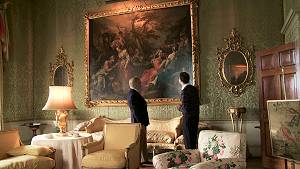 At last, towards the
end of the month things started to improve, both in the weather and within
the house. Andy's time was going to be rather limited and we had to complete
the shooting of him with Nick over a period of two half days, of which, at
the best, one could only expect to have useable light for about four hours
per day. Before the shoot, I decided to see just how the camera would perform
in the gloomy house. My original intention was to light each room as required,
but after taking a couple of trial shots in the entrance hall and library
it was apparent that there would be inadequate time to light each room and
I also preferred the images obtained with the natural lighting.
At last, towards the
end of the month things started to improve, both in the weather and within
the house. Andy's time was going to be rather limited and we had to complete
the shooting of him with Nick over a period of two half days, of which, at
the best, one could only expect to have useable light for about four hours
per day. Before the shoot, I decided to see just how the camera would perform
in the gloomy house. My original intention was to light each room as required,
but after taking a couple of trial shots in the entrance hall and library
it was apparent that there would be inadequate time to light each room and
I also preferred the images obtained with the natural lighting.
The lighting comprised a mixture of mainly daylight and some incandescent light from the house's often-flickering lamps; the NT allowed me to roll up the blinds that normally covered 50-75% of each window to get the most out of winter's overcast days. Even then, the interiors remained poorly, though atmospherically lit and I was going to have to work with the camera's iris fully open, +6dB gain and often with 360 degree shutter; higher gain could be used, but I wanted to be sure that there would be as little noise in the picture as possible.
The final release for the NT was to be on a standard DVD and, although I have often noticed an HD image appears less noisy when down converted to SD, I also wanted to create an HD version. To keep noise artefacts as low as possible, I also decided to turn off the camera's sharpening feature, preferring to sharpen in post where the impact of visual noise may better be seen on the large screen.
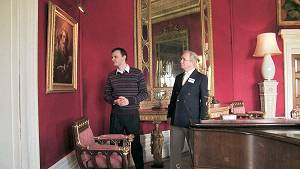 On the first day of
the shoot Nick, Andy and I met at the stepped entrance to house to film the
introduction; the weather was overcast and the imagery bland and lacking
any depth or punch, but we had to go with it. Having completed the intro
we ascended the steps to the entrance hall only to find that much of it was
still in the winter wraps. This was despite the NT resident staff having
been told that we were to film that day, but I must say that once they were
aware of the problem, they did everything they could to quickly remedy the
situation. However, as we proceeded from room to room it became evident that
all rooms were in such a state; it was necessary to remove the many cloth
wraps from the furniture and paintings, find the ornaments, remove them from
their tissue wrapping and place them on the furniture before we could film.
On the first day of
the shoot Nick, Andy and I met at the stepped entrance to house to film the
introduction; the weather was overcast and the imagery bland and lacking
any depth or punch, but we had to go with it. Having completed the intro
we ascended the steps to the entrance hall only to find that much of it was
still in the winter wraps. This was despite the NT resident staff having
been told that we were to film that day, but I must say that once they were
aware of the problem, they did everything they could to quickly remedy the
situation. However, as we proceeded from room to room it became evident that
all rooms were in such a state; it was necessary to remove the many cloth
wraps from the furniture and paintings, find the ornaments, remove them from
their tissue wrapping and place them on the furniture before we could film.
Although I could film specific items later it was still necessary that they should be correctly positioned in any wide shot of Nick and Andy so this delay imposed greatly on Andy's limited time and meant that we really had to try to get everything right the first time. As we walked around the house I would take two or three shots from different angles for each 'interview' and it was here that Andy's experience really helped. He was extremely good at remembering his position and movement throughout each shot and was always in the correct position for any following shots from a different camera angle; this greatly helped in the editing process.
Following my usual practice, I would remind Nick of my earlier questions and his responses and suggested that Andy ask similar questions, but using his own words. This worked well and we only needed to do one or two retakes with both of them. (Later, after the first edit, it was necessary to re-film a couple of Nick's responses. More about that later.) In spite of the poor light and having to wait for rooms to be prepared, we managed to get all the talking to camera shots in the bag within the two days available, actually within eight hours. In the next few days, I was able to get the remainder of the cut-aways and general room shots needed; most shots were taken with the camera mounted on a tripod, but the tracking shot in the Octagon room was taken from a wheel chair, and like the view of that room's ceiling, it was taken hand held.
The assembly of the various shots into a cohesive edit was relatively straightforward, but a lot of work was required to improve the imagery: some colour correction was necessary from time to time, but it was by the use of the Y curve, sharpening and blending tools available within Edius that I was able to salvage the originally bland footage.
As with all productions, it is important to choose appropriate music to accompany and support the visuals and, quite by chance, in January, I had recorded some Haydn scherzandos for the Haydn Society of Great Britain and I felt that extracts from this recording would be most suitable; subsequently I obtained HSGB's agreement to use extracts from this CD.
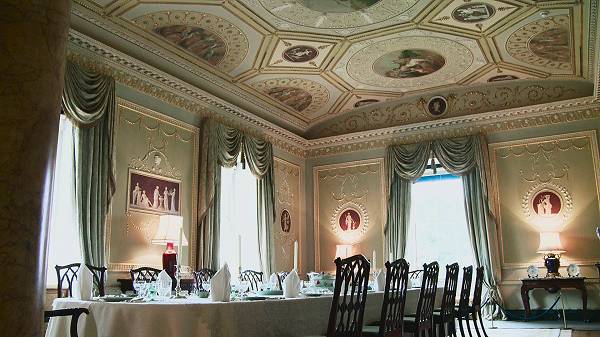
At the end of the 2009 season, it was decided that three minor changes should be made to the video.
- Nick wanted to correct one of his responses where he had said 'Baron' rather than 'Baronet' and
- I wanted to tidy up another one where he referred to 'the selling point of the house' rather than 'a selling point for the house'.
- The third change was for visual purposes, I felt that the long shot of Nick and Andy discussing a door was too long.
Over-dubbing Baronet to replace Baron was a simple matter; fortunately, there is little difference in the appearance of the mouth for the two words. The other two corrections were to be more challenging, once again the problem arose as a result of poor communication.
When Nick and I arrived at the house at the end of the 2009 season not only had all the exterior walls been enclosed by scaffolding and blue polythene, but the entrance hall and the octagon room, where we were to film, were completely devoid of all furniture, paintings and soft furnishing. The windows were boarded over to prevent damage from the workers carrying out essential repairs and there was no artificial lighting either! Following some hectic negotiations with the lady repairing the curtains we managed to get one curtain hung by the window in front of which Nick had to stand; the shot had to be a close up of Nick in order to avoid seeing the boarded window or internal scaffolding and I had to rely on the PAG Light for illumination. Similarly, the same problems existed in the Octagon room and, once again, I had to use a close-up of Nick to replace the original footage, but unfortunately due to the mess in the room, this had to be a very short shot and I would have much preferred a longer one. Hey, Ho!
The completed DVD was ready by the end of the first week in March and has been shown continuously since. Both Andy and Nick have been complemented and the format seems to have been well received with many favourable comments from both young and old.
- Geoff Addis
- The National Trust website's section on Basildon Park starts here.
- Wikipedia page on Basildon Park is here.
- Haydn Society of Great Britain website, from which you can buy the CD of the music used in Love Basildon Park, is here.
- the Paglight website for lighting and other equipment is here.
Lest you think the title a bit strange ... it is the title of a National Trust booklet promoting the house.
Share your passions.

Share your stories.
